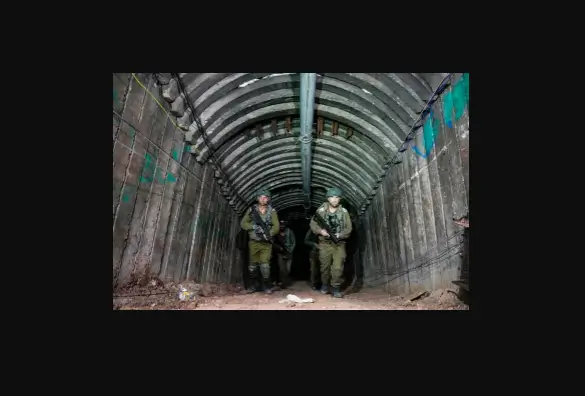Tunnel in Gaza Once Held 20 Hostages informed by the Israeli Military.
The kilometer-long tunnel discovered by Israeli soldiers in the Gaza Strip sheds light on the harsh conditions endured by hostages.
The holding area, consisting of narrow rooms, metal bars, toilets, mattresses, and drawings by a freed child hostage, illustrates the challenging circumstances.
Read More: South Africa Requests ICJ to Stop Israel’s Genocide in Gaza
The tunnel, concealed beneath the house of a Hamas member in Khan Younis, became a focal point of Israel’s recent efforts against the Palestinian group.
The tunnel’s booby traps, blast doors, and explosives showcase the complex infrastructure. Although no hostages were present during the discovery, the accounts suggest that about 20 individuals faced harsh conditions, lacking daylight and dealing with dense air, limited oxygen, and severe humidity.
Read More: Pakistan Sends 3rd Aid Cargo for Gazans
Some hostages were released during a truce, while others remain captive in Gaza since Hamas’ October 7 incursion into southern Israel.
Journalists documented the tunnel before its destruction, providing a glimpse into the perilous conditions faced by the hostages.
The revelations surrounding the kilometer-long tunnel in the Gaza Strip, discovered by Israeli soldiers, expose the dire conditions endured by hostages.
The holding area, equipped with narrow rooms, metal bars, toilets, mattresses, and poignant drawings by a child hostage freed during a November truce, provides a poignant snapshot of their challenging circumstances.
Read More: Canada Offers Temporary Visas for People in Gaza
Situated beneath the residence of a Hamas member in Khan Younis, this tunnel became a focal point in Israel’s recent efforts against the Palestinian group.
Booby traps, blast doors, and explosives underscore the tunnel’s sophisticated infrastructure, revealing the lengths to which Hamas went to secure it.
While no hostages were present during the discovery, accounts suggest that approximately 20 individuals experienced harsh conditions, including a lack of daylight, dense air, limited oxygen, and severe humidity.
Read More: Israel Intensifies Gaza Attacks: Communications Cut Off
Some hostages were fortunate to be released during a week-long Qatari-mediated truce, yet others, among the 130 captured during Hamas’ October 7 incursion into southern Israel, remain in captivity in Gaza.
The military released photos from the underground labyrinth, providing visual documentation of the cramped cells, toilets, and living conditions that hostages endured.
The presence of journalists during this documentation highlights the Israeli military’s efforts to share the evidence of these conditions with the international community.
Read More: Israel Hit Hospital in Gaza: 300 Killed Instantly
The discovery of such tunnels underscores the complexities of the conflict, revealing the lengths to which militant groups go in constructing and maintaining underground networks for both military and civilian purposes.
Note: The information above might not be accepted 100%. Please verify from your own sources. We will not be responsible for any kind of loss due to our content.
For more news, please visit Munafa Marketing.




